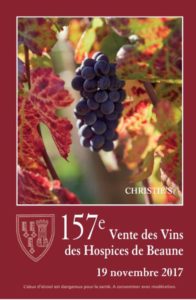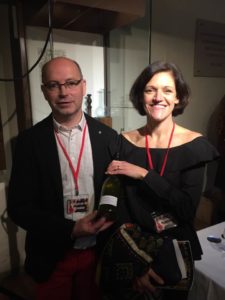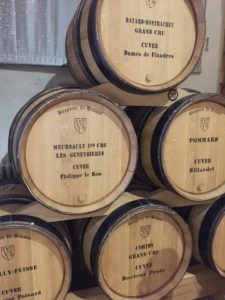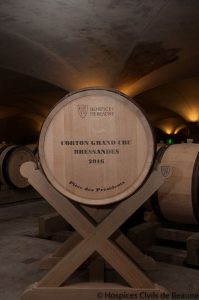157th Hospices de Beaune Wine Auction
157th Hospices de Beaune Wine Auction
“A new Cuvée, a great quality and more wines for this 157th Hospices de Beaune Wine Auction“
The 2017 Vintage will offer to buy 787 barrels called pieces, 630 pièces of red wine and 157 pièces of white wine. There will be 50 different cuvées at the wine auction – 33 of red and 17 of white.
A new director for the Hospital…
Hospices de Beaune welcomed their new executive director, Mr François Poher, on 24 August 2017.
As a Hospital director since 1994, Mr François Poher has held various responsibilities in public hospitals and has also run a private clinic specialised in visual impairment for 10 years. He previously worked as financial controller in distribution and transportation companies and was a teacher. After a recruitment process carried out jointly by the Regional Health Agency of Bourgogne Franche- Comté and the Supervisory Board’s Chairman of the Hospices and Mayor of Beaune, Mr Alain Suguenot, the new director took office on 24 August 2017.
“Caring about people, is about giving them careful attention, joy and reasons to hope.”
 Tradition always presents at the Hospices de Beaune…
Tradition always presents at the Hospices de Beaune…
In 2017, thanks to Bernard Clerc, a new prestigious vintage will enter the Hospices de Beaune’s range.
This year the Domaine Henry Clerc domain has given a parcel of 2000 square meters in the famous appelation Puligny-Montrachet. These vineyards are about forty years old and in the Climat “Les Reuchaux” in the northern part of the appellation (Meursault side). After the harvest, Ludivine Griveau, vineyard manager of the Hospices de Beaune wine estate since 2015, will be charged with the responsibility for the vinification of the new vintage, which now enriches the 49 cuvées of the Hospices de Beaune. The vintage will bear the name of the donor and will be offered in the 157th Hospices de Beaune’s wine auction, on 19 November 2017.
Two recent donations to the Hospices de Beaune’s date from 2011 and 2015, one with a parcel of Grand-Cru Echézeaux (Côte de Nuits), and the other with one of Chablis Premier Cru Côte de Léchet.
The Hospices de Beaune 2017 Vintage seen by Ludivine Griveau, winemaker and manager of the Domaine des Hospices de Beaune : “2017, The equilibrist”
“Climatology ; Following a very sunny autumn, especially with a month of October with temperatures close to what we might see in summer, it has been a long time since we had a real winter.
Even though the sun shines in December and in January it is still very cold; we record seven days without a thaw in December and twenty days in January. Rainfalls are also quite different from previous years, being considerably lower this year, but everything changes in February and March – they are warmer and brighter (+ 2°C above average). We look forward to a rapid start to the growth of this year’s vintage.
 Sunshine in early April is abundant and rain is rare, it is the opposite of 2016. The end of the month is more chaotic, and everyone scrutinises the weather forecast which suggests that there is a significant risk of frost but the weather stays dry and the wind helps move the weather on. We reassure ourselves that the buds usually resist at -3°C… however the humidity on 27 and 29 of April gives us cold sweats and sleepless nights. Indeed, during two consecutive nights, the winemakers of the Côtes and Hautes-Côtes villages are doing their best to watch the cloud cover at the dawn… In the end, the damage is very localised and contained. However, we think of our neighbours whose vineyards are damaged, losing almost everything.
Sunshine in early April is abundant and rain is rare, it is the opposite of 2016. The end of the month is more chaotic, and everyone scrutinises the weather forecast which suggests that there is a significant risk of frost but the weather stays dry and the wind helps move the weather on. We reassure ourselves that the buds usually resist at -3°C… however the humidity on 27 and 29 of April gives us cold sweats and sleepless nights. Indeed, during two consecutive nights, the winemakers of the Côtes and Hautes-Côtes villages are doing their best to watch the cloud cover at the dawn… In the end, the damage is very localised and contained. However, we think of our neighbours whose vineyards are damaged, losing almost everything.
Freshness continues at the beginning of May and summer arrives earlier than expected with temperatures close to 33°C and exceptional sunshine until the end of the month. Rainfalls become regular, which is a relief for our vineyards! Meanwhile, the Agriculture Chamber warns us: “the deficit is significant” compared to 2016 when the deluge of rain broke records.
In June, the periods of high heat continue but are interrupted by episodes of rainstorm which lead to highly variable conditions (20 to 50 mm in 7 days). The last week of June is scorching with temperatures reaching 38° degrees in the shade. The plantations are thirsty.
Thunderstorms continue in July but are interrupted by much cooler periods showing significant thermal amplitudes from one day to the next. We are also acutely aware that the water deficit continues, and we lack 30 hours of sunshine this month which the Chamber of Agriculture declares to be the same as the month of May!
August is more even, except for a cool and grey week around August 15. The wind, present since the beginning of the vintage, continues to clean up the vines. At the end of the month, the vineyards are green and the grapes are clearly visible. The first grapes of the Domain, at Chaintré, are cut under a blazing sun on August 26th and 27th. The rest of the Côte d’Or’s plots are harvested, from September 1st for the Chardonnay and September 2nd for the Pinot Noir.
The Vegetative cycle: Following a mild spring in February and March, the vine shows first signs of vegetative activity around March 20. The growth is faster than expected and with the coolness retuning, things calm down a bit until early April. On March 28, there are green tips in the earliest growth areas. Therefore, we expect this vintage to be premature as the 2014 and 2011 vintages were 15 days in advance of 2016!
Throughout April, the vegetation accelerates in its development and the “attaching” work ends quickly. The rhythm is intense, and we see between three and five leaves by April 20!
It is rather variable in in the development within the plots of the domain and difficult to establish a trend in either the young vines or older ones. We are more tense at the end of the month when we hear of a risk of frost. A year later, on the very same day (27th of April) Burgundy holds its breath and all the wine makers deploy an unprecedented collective action to save the harvest. In the early morning, the verdict comes: the young buds are safe in most plots.
During this time and until early May, tillage is suspended to prevent moisture from rising. The vines are pale green, slowly recovering from the cold, dry snap. However, we notice the emergence of many buds so we decide to start the long and precise process of disbudding within all the plots of the domain.
From mid-May, the vine grows at a fast pace, with the growth of three to four leaves a week! The end of May is very warm which accelerates the growth rate and we expect to see the first flowers soon enough.
Chardonnay plots reach full bloom the week of May 30 and a week after it is the turn of the Pinot Noir. We choose to limit the risk of sagging and wait for 50 to 75% to flower before cutting the branches. Sometimes the branches are long but it is necessary to encourage the influx of sap towards the fruit rather than the branches.
We are ahead of ourselves, which helps to avoid disease and gives us the time to carry out the necessary green operations in full active growth. It is necessary to keep up the pace because the changes in rain and heat are very favourable to the vine. Hospices de Beaune chooses to entrust an area of 2.5 Ha per winegrower, which, even in this time of intense growth, gives plenty of time for the essential work of lifting, binding and ploughing.
The berries of some Chardonnay plots have already reached two to three mm in mid-June, 2017 is therefore is likely to be one of the three earliest vintages of the last 10 years. This pace remains strong in June and July with a consistent development in the Pinot Noir. However, we detect some, quite significant, run out in the Chardonnay (rapid budburst + heavy showers + strong heat).
Until June 28, the heat is overwhelming which sometimes stalls the development of the vines, even showing some signs of drought: yellowed leaves, roasted clusters. The leaf stripping is conducted early in the Pinot Noir plots (June), the fruits have acclimatised themselves to the heat and sun. The most important damage is seen on the grapes that have had more brutal exposure. Around July 10, the clusters have sometimes reached the stage of closure: it is similar to 2007 and 2009 in terms of their advanced state and at this stage the date of the harvest seems likely to be the end of August/beginning of September. An episode of hail on the Côte de Nuits makes us shudder again, but it is the last big weather alert of the year.
 Rain showers are sometimes the cause of large volumes of water, however they are very unpredictable: Vosne displays 90 mm when Pommard gets “only” 50 mm. Around 15-20 July, the first logs tinged in red because of the bunch’s closing. This is three weeks earlier compared to 2016, so we start preparing the vat room and the whole equipment.
Rain showers are sometimes the cause of large volumes of water, however they are very unpredictable: Vosne displays 90 mm when Pommard gets “only” 50 mm. Around 15-20 July, the first logs tinged in red because of the bunch’s closing. This is three weeks earlier compared to 2016, so we start preparing the vat room and the whole equipment.
In early August, the vines are at a half-veraison stage. The full veraison takes longer than expected because the second part of August is cooler and especially less bright (cloudy but warm). It ends around 21-25 August. The crops are very healthy, we’re confident that we will manage the get mor heterogeneous and mature grapes than grapes damaged by botrytis, which is almost absent at this stage.In the last days of August, the Pinot Noir becomes sweet and the Chardonnay tastes more and more balanced. Once again, maturity checks and berry tasting are essential. We make the choice to conduct these controls again on the entire domain, 117 parcels. On 21 August, we start our ripeness checks. The harvest is healthy, the Chardonnays seem to be ahead of the Pinot noir: nothing like 2016!
The condition of the crops is truly superb and the weather is more than lenient, we thus have the time to harvest our grapes at perfect maturity. We harvest our first Pouilly Fuissé Chardonnay grapes on 26 and 27 August and on 1st September in Côte de Beaune. At the same time, the ripeness checks on Pinot Noir are unanimous: we must start! The first ones arrive in the winery on 2 September. All the grapes were of course sorted on the sorting table. We noticed that the harvest was quite abundant, as expected, and our farming methods produced excellent results with perfectly controlled yields as usual.
This year, the tasting of Pinot Noir berries brings to our attention some tannins and colors that will have to be extracted. This manipulation will require a certain “technicality” but it is fine because we have the experience necessary to carry out this balancing act that is sometimes essential to Pinot Noir. On the other hand the Chardonnays are dense and the wine presses are adjusted on a case-by-case basis. »
The “Pièces des Présidents” of the 2017 Wine Auction
 For this 157th sale, the Pièce des Présidents will offer two barrels of 228 litres: Cuvée des Présidents. the two barrels from the 2017 harvest, are from the appellation Corton Grand-Cru Clos du Roi.
For this 157th sale, the Pièce des Présidents will offer two barrels of 228 litres: Cuvée des Présidents. the two barrels from the 2017 harvest, are from the appellation Corton Grand-Cru Clos du Roi.
Indeed, Hospices de Beaune have selected two pieces of 228L Corton Grand Cru Clos du Roi which will be offered for sale to the benefit of the charities selected for the 157th Wine Auction of the Hospices de Beaune, on November 19th.
The Clos du Roi is one of the most majestic climats located on the renowned Corton hill in Burgundy. Since the sixteenth century, this wine has been served at the Royal Court, giving it its current name. Lying next to other climats including Foxes, Bressandes and Perrières, the Clos du Roi faces East and rests on the top of the hillside, on a limestone bedrock.
The Hospices de Beaune have about 0.85 ha of this climat, with plots of about 20 to 45 years old, which are part of the Baronne Du Baÿ vintage. The result is a dense wine with a velvety feel that is also full-bodied with a particularly mild vintage and tannins. Already after leaving the tank, it is a wine that perfectly illustrates this beautiful 2017 vintage: generous and balanced.
Charities…
In 2017, following the all too frequent climate events that took place around the world, from violent hurricanes to earthquakes, the Hospices de Beaune felt the need to look ahead to the future of humankind and chose to donate the funds from the sale of one of the Pièce des Presidents to the Tara expeditions Foundation. This non-profit organization has been active since 2003 in favour of environmental causes.
Always keen to advance scientific research, the Hospices de Beaune also chose two medical associations. The first one is The Federation for the Brain Research represented and supported by Marc-Olivier Fogiel in 2017. The second association is the Foundation for the Alzheimer Research supported by the famous French singer Charles Aznavour. The mission of this foundation is to support research on Alzheimer’s disease and concentrate on clinical research to improve diagnosis and develop therapeutic pathways.
©HospicesdeBeaune
